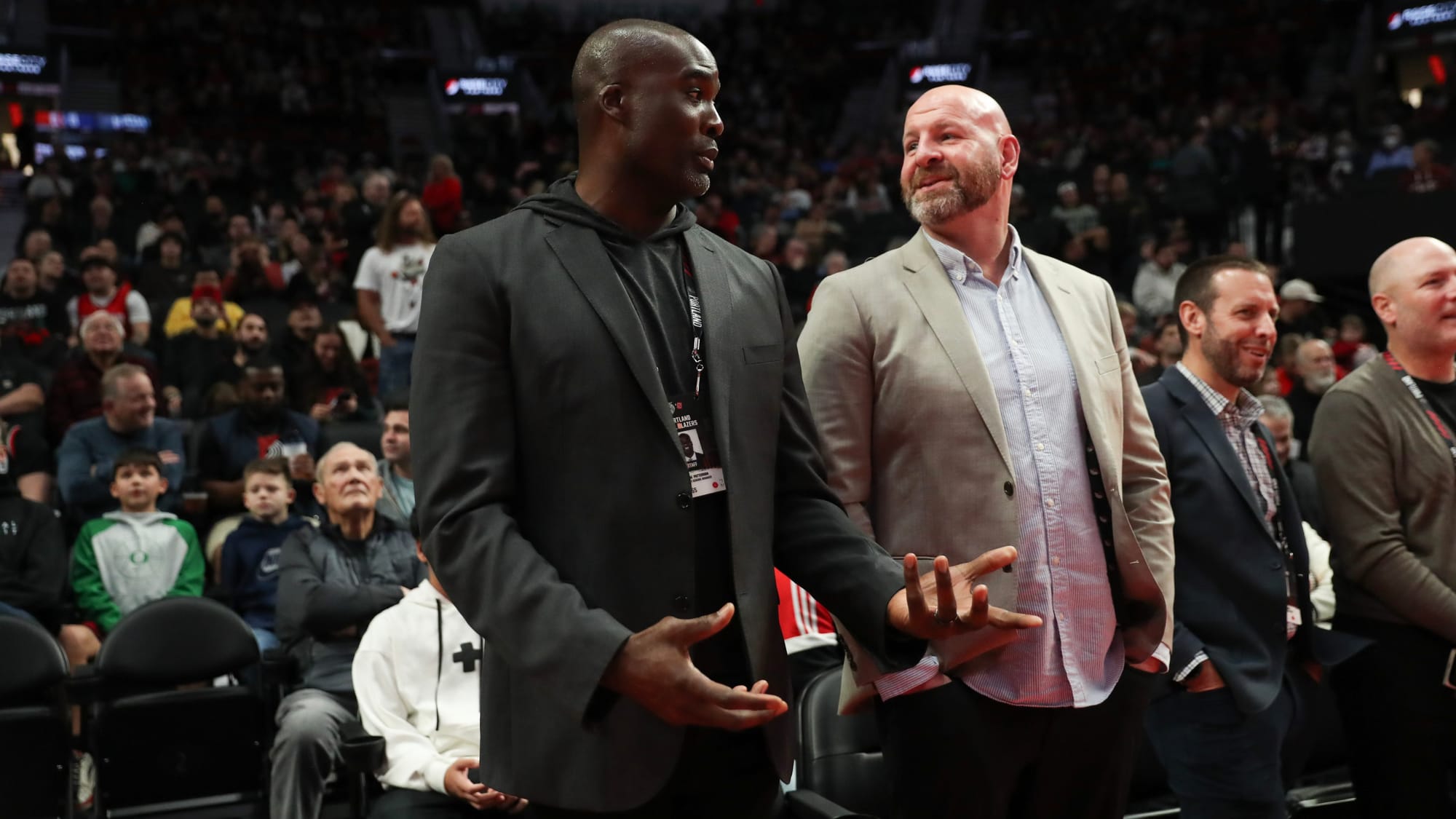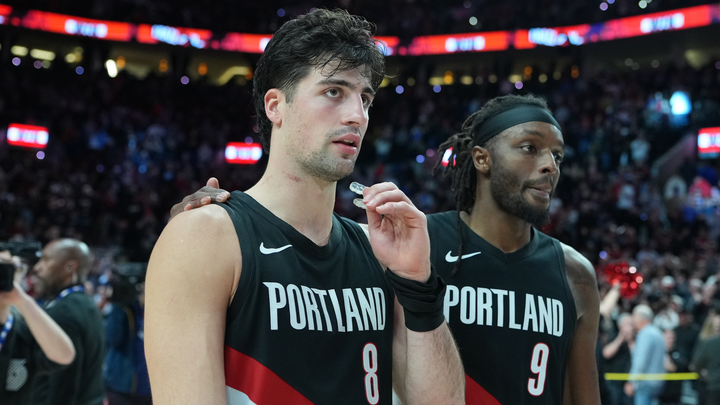The Trail Blazers Weren't Supposed to Be This Bad
Searching for the "daily improvement" the organization wanted in the first year of the rebuild following a disastrous road trip.

By scoring margin, the Trail Blazers’ embarrassing 62-point blowout loss in Oklahoma City on Thursday was the second-worst loss in franchise history. But it wasn’t even the worst loss of a truly disastrous seven-game road trip.
That would be the one last Friday, the second of two in Dallas. It’s difficult to lose both ends of the “baseball series” against the same team, but after being blown out by 29 by the Mavericks in the first game, Portland lost by even more (36) in the second game even with Luka Doncic sidelined.
If anything should have told you what was in store for the rest of the road trip, that was it.
Here are the final stats on the Blazers’ 12-day trip:
- A win-loss record of 1-6.
- A final point differential of -192 over the seven games, including the game they won in Brooklyn. Of the six losses, the closest final margin was 21 points against Phoenix in the opening game of the trip.
- Anfernee Simons: 31.4 percent shooting, 34.2 percent from three-point range. Scoot Henderson: 34.1 percent shooting, 3.7 turnovers per game. Shaedon Sharpe, before he re-aggravated the adductor injury in the Oklahoma City loss: 38 percent shooting, 20 percent from three-point range.
- Deandre Ayton missed all seven games of the road trip as he continued to deal with right knee tendinitis. Jabari Walker missed four games with a left knee injury. Sharpe, Simons, Duop Reath, Toumani Camara and Matisse Thybulle each missed one.
Outside of Ibou Badji getting real minutes, there isn’t anything redeeming about the basketball Portland is playing right now.
Blazers general manager Joe Cronin had an answer back in October on media day, when he was asked how he’d measure success in a rebuilding season that wouldn’t be judged on wins and losses.
“Daily improvement,” Cronin said then. “This is going to be a group that, while very talented and very capable and hopefully incredibly fun to watch, they have a lot to improve on.”
One thing nobody would call this team right now is fun to watch. Or watchable at all, for that matter.
It wasn’t supposed to be like this, at least not this early in the season.
These games have been as non-competitive as the Blazers’ post-trade deadline tank jobs of the last two springs. But this stretch feels worse because they aren’t (yet) chasing lottery odds. The players getting heavy minutes—Henderson, Sharpe, Simons, Camara, Walker—are the ones that will, in an ideal world, be a part of the organization the next time they’re in playoff contention. They aren’t conjuring up injuries for veterans who could play and replacing their minutes with G Leaguers with no NBA future.
This is their team, and it looks like this.
For the first six weeks, the outline was there for what a successful post-Damian Lillard future could look like for the Blazers. Henderson, the No. 3 overall pick and heir apparent to Lillard, started out rough but began to figure some things out after a move to the bench. Sharpe showed signs of making a leap. Simons missed six weeks with a thumb injury but didn’t miss a beat when he came back. Camara, a throw-in from Phoenix in the Lillard trade, forced himself into the starting lineup as a rookie by bringing a defensive edge. Ayton, when engaged, looked like he could be the mobile two-way center the organization always wanted Jusuf Nurkic to be.
They lost a lot, but they were always going to lose a lot. Young teams do. But Chauncey Billups had them playing hard and giving teams a scare. The fans, readers and subscribers I heard from in that time loved it. This was exactly what you want in a rebuild—you get to see some development from the young guys, and then get a good draft pick as a reward.
Many of those same people couldn’t be more checked-out and apathetic now. Over the course of one road trip, all of the progress and positive indicators unraveled, one after the other. The “At least they compete!” spin on the losses has worn off after they lost six games by 20 or more on the trip, including the 62-point loss in Oklahoma City. The most important young players are either regressing from where they were a month ago or not being put in positions to succeed.
The vibes—the most important indicator for how a team’s season is going, regardless of title expectations—went from “pretty good considering the record” to downright awful in a matter of weeks.
This is a more talented roster than teams in the early stages of a rebuild typically have. Simons, Ayton, Thybulle, Jerami Grant and Malcolm Brogdon are proven above-average NBA rotation players, even very good ones. The younger, less-proven players like Sharpe, Henderson and Camara all fit a specific type of player that Cronin and Billups have targeted to build the organization’s post-Lillard identity.
You could see at the beginning of the season what they were trying to do.
“Our goal was to get way more athletic,” Cronin said back in October on media day. “Way more physically capable. Better defensively. A team that’s going to play with pace and play uptempo. A team that’s going to share the ball. That’s going to trust each other and stay connected and play the brand of basketball that Chauncey wants to play.”

With about half the season gone, they’re 0-for-3 on those self-declared goals.
Better defensively? In Cleaning the Glass’ version of the defensive-rating stat, which filters out garbage time (and there’s been a lot of that lately), the Blazers are seventh-worst in the NBA, giving up 118.5 points per 100 possessions.
Playing with pace? They’re currently 18th in the NBA in that category with 99.14 possessions per game, while also having the league’s fourth-worst turnover rate.
Sharing the ball? They’re currently dead last in assist percentage and the NBA’s tracking data shows them making the fifth-fewest passes per game.
Billups has talked many times this season about wanting the new-look Blazers to be the team other teams don’t like playing. After the last two weeks, it’s hard to see how the NBA’s other 29 teams can see Portland on the schedule and do anything other than pencil in a “W.”
These stretches come with the territory of a rebuild. The Thunder team that annihilated the Blazers on Thursday is just over two years removed from losing a game to Memphis by an NBA-record 73 points and now, through smart drafting and roster management, are a legitimate Western Conference Finals threat.

That doesn’t mean every team currently as bad as Portland will one day be as good as Oklahoma City. That’s asking Henderson or Sharpe to become as good as Shai Gilgeous-Alexander in short order as Cronin drafts the next Chet Holmgren in one of the upcoming drafts. Maybe it will happen, but you can’t count on it.
This was always going to be a multi-year process for the Blazers in the post-Lillard era, with the beginning the most painful. They’ll probably move Brogdon, and maybe one or two other players, at the deadline to open up even more minutes for the kids. I still don’t expect a coaching change to happen in-season, as much as some fans are clamoring for it. The best hope for everyone involved is for the players who matter to stay relatively healthy the rest of the way, so Billups has a chance to sink or swim with the roster he wanted, and Cronin and his staff can evaluate both coaching and on-court talent with a real set of data.
You might say it can’t possibly get worse than this road trip.
To that, I say: There are still 44 games left.






Comments ()